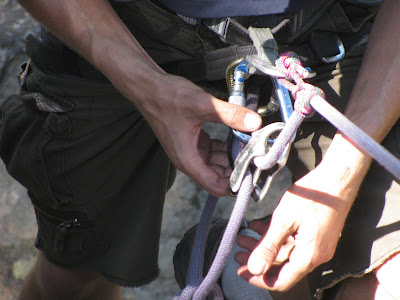First, if it is possible to safely walk off from the top of a climb, simply walk off. Limiting the amount of time that you spend rappelling is a surefire way to limit the amount of exposure that you have to potential mistakes.
Second, climbers should always try to tie off the ends of their ropes in order to close the system. This is a simple thing to do that is often overlooked. Some climbers are afraid that their ropes will get stuck after they throw them...which is a legitimate fear. Closing the system should be a default tactic. But if there are extenuating circumstances, then perhaps the system should be intentionally left open.
I have recently started to experiment with tying the ends of the ropes off and clipping them to my harness. In a multi-pitch rappel setting this decreases the likelihood of ropes getting stuck below the next belay station, as well as providing the security of a closed system.
People seldom think about tying knots in the end of the rope in single pitch terrain, but ironically, that's where most people accidentally rappel off of a single end of the rope. All that it takes is a minor rope offset to ruin your day. Knots in the rope will keep such a thing from being anything more than another minor element to fix.
There are two friction hitch backup options that are commonly used. Some people like to put a prussik hitch above their rappel device, whereas others prefer to put an autoblock hitch below the device. There are advantages and disadvantages to rappelling both ways. The biggest advantage to either of these options is that you are less likely to die if you make a mistake. The biggest disadvantage is that it takes extra time to put these things together...
Most people will put their hand on the autoblock hitch while rappelling. You might notice that the backup in this scenario is on a non-locker. Generally, you don't need a locking carabiner for a back-up, but if you want more security, you can certainly use one.
Rappelling with a friction hitch above the device has gone a bit out of fashion. One advantage to rappelling with a prussik hitch above is that it is easy to switch a rappel system into a rope ascending system. The prussik is already attached to the climber's belay loop, so all that he has to do is to add a second friction hitch for his feet below the first friction hitch. That said, in a free-hanging rappel, if the hitch gets loaded, it can be hard to release it.
Most climbers now rappel with a friction hitch (usually an autoblock hitch) below the device, attached to a leg loop. This allows both hands to hold the rope below the device which provides for more redundancy in the rappel.
Rappelling is the most dangerous thing that we do. So why not create more security by trying to walk off when you can? Or by tying knots in the end of the ropes? Or by putting a friction hitch into the system? Any one of these simple techniques could save your life...
UPDATE:
AAI Guide Andrew Yasso recently received the following text from a student that he taught this material:
Sup Andrew!
It's ******, ***** *****'s nephew, the kid you took climbing and lent a crash pad too. Hope all is well.
Anyway, just wanted to share some photos!
That knot you showed me saved a 4 foot fall due to miss judging how much rope i need for a rappel!
This is a great example of why we should always close systems and use friction hitches to back up rappels!
--Jason D. Martin







4 comments:
This should be a given, but the importance of always testing your rappel line by putting weight on it before coming off your personal anchor can't be stressed enough.
Walking off isn't zero risk either. Evaluating your options and choosing an appropriate course of action is important. Sometimes a rappel is safer than walking off.
Hello, on first excuse my bad english...
Good article...every write/speak about make rapel more safe is allways good
Some comments...it's not really a backup if it is not enuogh to support your weight on similar safety conditions
If you use locking carabiner on rappel device and a non-locking carabiner on backup...it's not enough backup
If you use less than 7mm cordelete it's not enough backup, it should support your weight enough for auto-rescue tasks
And if you clip carabiner+knot on your leg loop really really it's not backup, leg loop is not designed for support your weight
That's what I think...so use locking carabiner, at least 7mm cordelete (or some kind of locking devices as shunt, etc) and clip to harness main loop, that will become really a backup
Thanks!!!
Hi! I have a question. I anticipate spending a lot of time on a tall ladder and an elevated platform about 30 feet above the ground this winter. Sometimes I expect there will be icy conditions. i am wondering if there is some arrangement of ropes and equipment from mountaineering that I could use to save myself If I should slip and fall. I could leave ropes permanently and solidly anchored at the top but I am hoping for something that could stop me from falling if I should slip suddenly without anticipation--something like a one-way ratchet or something that allows you to lower yourself slowly but catches if you are falling faster. If you were facing this situation, say as a work environment, what sort of safety equipment would you want or reccomend.
Thanks! --Andrew
Post a Comment